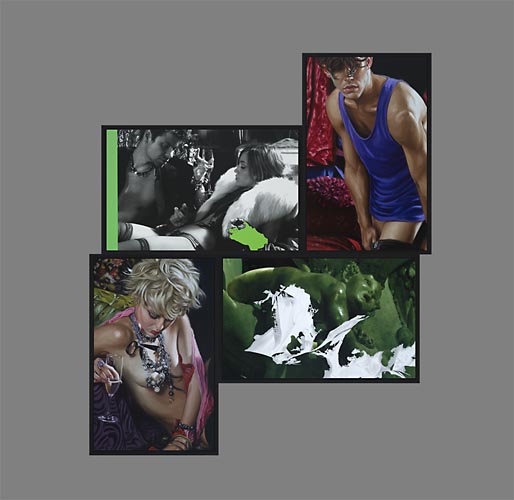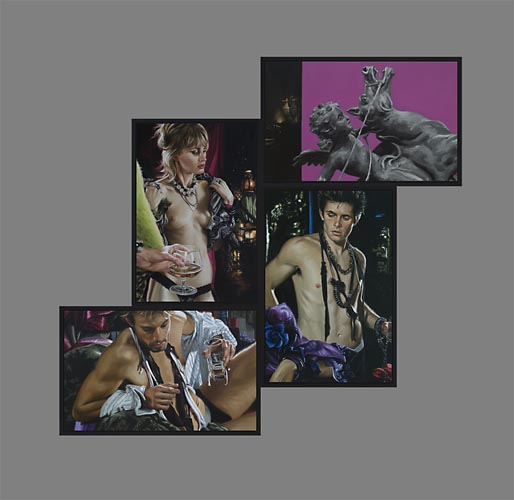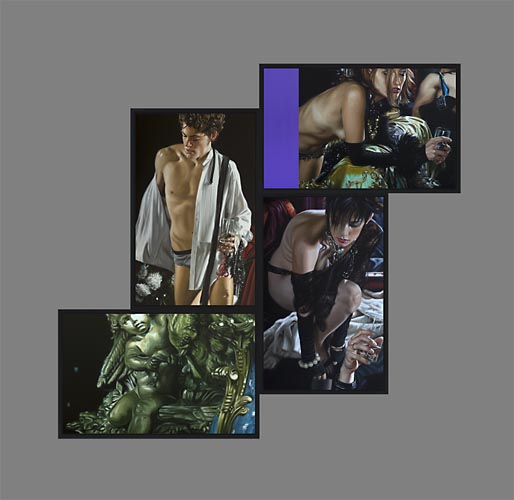The Fox and the Grapes - New Work by Terry Rodgers
By Emiel van der Pol, Art historian
A state of perpetual cognitive dissonance seems to be inevitable for any contemporary human trying to carve out a meaningful existence. New ideas and discoveries surface as quickly as they are discredited. History is reinterpreted and made present again, the future represents a frightening number of choices that must be made. Terry Rodgers offers his public fragments of this impermanent and imposingly fluctuating status quo.
His new body of work, descriptively called 'quads', can be interpreted as an attempt at atonal cognition. When you no longer accept an overarching or guiding harmony of ideas to base your identity on, the excerpts of these ideas can neither be consonant nor dissonant with your own composition of life. Terry describes a fluid identity, a set of contextual vectors forming the framework for a temporary sense of self. Half-understood half-truths are connected in a convincing and alluring arrangement. This mirrors the fluid identities people seem to have adapted themselves to on the Internet. Here, fine-tuned fictions are created to match the demands and expectations of a community of other fictional presences. No wonder this is the golden age of the conspiracy-theory.

The 'quads' lay bare a comforting lack of structural reality that seems to be one of the driving forces behind Terry Rodgers' work. Through the tiny holes in a dense web of cultural signifiers spectators can peer into the great nothing. Luckily, the threads of recognition are strong enough to keep them from falling in. Terry has honed a photo-realistic style of painting that allows him to celebrate the surface of things while simultaneously referring to his material and to the story of art itself. In his latest work he combines this virtuoso technique with digital imagery and photography. The resulting images are interesting juxtapositions of the ideas and values attributed to each separate medium. Most of his compositions are based on photographic collages in which the artist freely plays with scale and form to let the things he photographs gradually lose their connection with their physical counterparts. In this digital realm their indexation to a specific place or time slowly dissipates until they become part of a dynamic archive of visual elements. Then, by painting selections from this archive on linen he gives these digital photo-objects their own solidity. This interesting story of origin is further emphasized by his chosen subject matter: sculpturally toned bodies, ornaments, jewelry and rich fabrics. All these displays of material wealth are stripped from their worldly weight and become equal players on a two-dimensional plane.
Terry Rodgers' earlier iconic pieces seem to celebrate a decadence that is equal parts collage, desire and reality. On large-scale canvasses he paints luscious settings with gorgeous youths sensually draped over expensive furniture while drinking fine liqueurs. These models behave like a tribe of ghostly poseurs. Ethereal, disconnected beings longing for any form of meaningful contact. With these works he describes how desire and decadence can act as the pastiche of an existential ideal. Now, this tribe has transformed and expanded through a shift in perspective in his work. His 'quads'' can be seen as depictions of the derailed daydreams experienced by the fictional presences populating these earlier works. These visions are combined with the associative universe of the artist himself. Arrays of four smaller works depict undressing and drinking figures cut off by contrasting hard-edged geometrical shapes in a vibrant colour. They are mounted beside digitally distorted paintings of baroque ornaments set in eerie lighting. It is like looking through the eyes of the ghostly poseur into a world that was haphazardly stitched together for a single moment.

In Cri de Coeur (2016, 59x49 inches / 150cx125cm, oil and mixed media canvas ) this new approach in can be seen in full effect. The piece resembles a misprinted page of a graphic novel with its mismatched colours and seemingly arbitrary cropping. Two digitally deconstructed photographs show an anguished ornamental stone devil covered in the inverted remnants of another photograph. Across from it an ambiguous encounter between a partly undressed man and a reclining fur-clad woman is printed in black and white. The aesthetic of this cinematic scene is violently broken by two striking sections of sickly green. These two photographic pieces are matched with two paintings: a well-built man awkwardly pulling his pants up (or down) and a young nude girl blushingly looking downwards with a glass of champagne in her hand. Contra-intuitively these paintings immediately pop out as the most relatable images in the arrangement while the photographic works seem to refer only to themselves. Terry expertly plays with ideas of authenticity and agency associated with both painting and photography. By mounting these four pieces together it seems evident that they should have a certain relation to each other. The spectator is forced to create connections where there might be none. This forced connection between vaguely related images alluding to grand ideas which haven't been completely thought out yet can be seen as a suitable metaphor for all human cognition.
The Boundaries of Desire (2016, 55 x 59 / 140cm x 150cm, oil on linen) is a playfully directed choreography of gazing and longing. Four painted figures seem to interact with each other in the way four statues might have an imagined telepathic conversation on a town square. Each figure occupies a separate space, an introverted vacuum of thought. The stark black frames of the pieces further emphasize the way these scenes play out alongside each other like alternate realities for the same moody evening. The little stone cherub rides his horse off into a pink void while the three human figures are left stumbling about in a bashful drunkenness. A disembodied hand offers the viewer a glass of brandy like it is the mystical entry ticket to this world of mild debauchery.

In The Grace of Angels (2016, 55 x 59 inches / 40cm x 150cm, oil on canvas) the artists' gothic sensibilities take the stage. Raven hair, black silk gloves and silver chains set the scene. All painted eyes are averted from the viewer except for the hollow gaze of a chubby ornamental angel. In the piece highly detailed sections are freely combined with loose brush strokes and an eye-catching purple rectangle. It becomes clear that even when all elements of the quad are hand painted, they are as much ephemeral digital impressions as they are tangible in their origin. The visible ease with which the artist switches between several registers of thought (surface, abstraction, representation and craft to name but a few) on a single surface gives the piece a pleasantly fluent dynamic.
In a sense the gothic subculture practices what Terry preaches. Their adherents add a theatrical grandeur to their life to elevate it somewhat above the mundane world of rational thought and sound decisions. And yet the models painted here don't seem to be authentic members of this particular subset. They seem too perfect, too poised to honestly take part in any organized group. To cover up their underlying existential insecurity they cover their bodies with the attributes of certain communities, perhaps in a vain attempt to connect with a larger whole. They play their parts: the wealthy dilettante, the bohemian dandy and the sultry seductress, but they can't really help but phone it in.
Pondering on the narrative possibilities of these quads can feel like circling a drain. A slowly moving vortex of historical references, seductive baubles and attractive bodies draws the viewer closer and closer to the sobering conclusion that there is no satisfying answer provided by any of these pieces. Terry tries to convey a way of seeing and of gathering information that doesn't have reaching a conclusion, making a choice, or passing judgment as its final goal. To really appreciate this work one must accept that all knowledge is incomplete and that most things are possible. This open-ended attempt to continuously complicate and mystify the human experience is a potent counter-strategy to the paralyzing global processes of data-gathering and systematic analysis. When ripe, succulent grapes can fall out of the sky at any given moment nobody cares about reaching those high branches.
2017